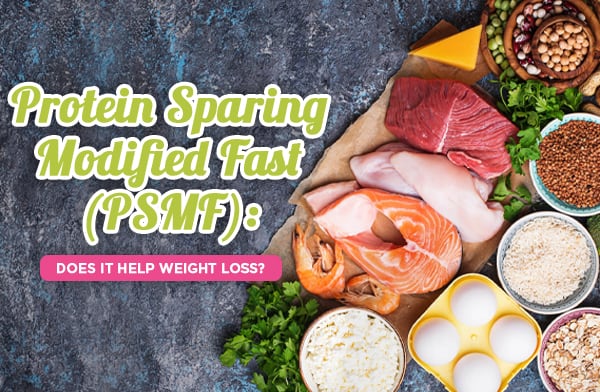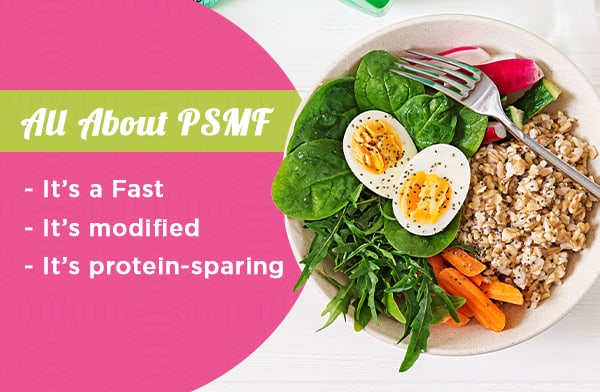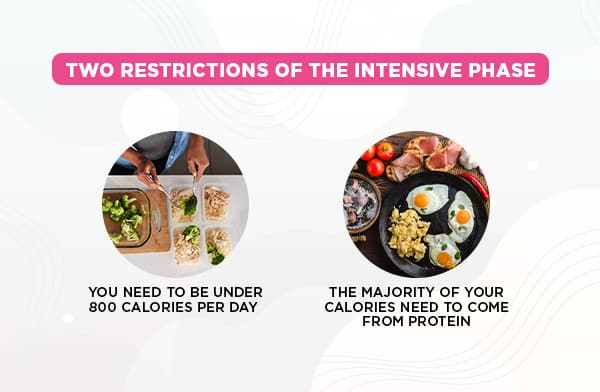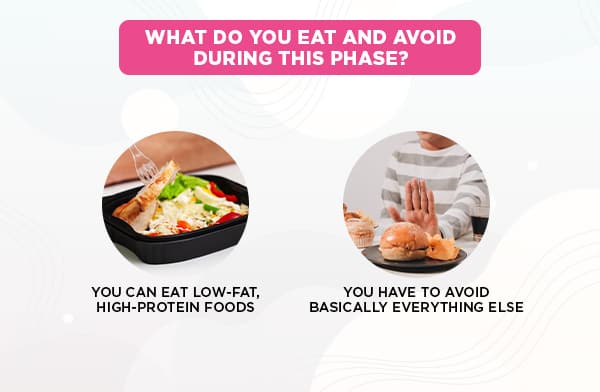Protein Sparing Modified Fast (PSMF): Does It Help Weight Loss?

Any time you want to lose weight, you have to modify the weight equation.
The weight equation is simple: calories in, calories out. If you burn more calories than you take in, you lose weight. If you take in more calories than you burn, you gain weight.
There are modifications to this equation, of course. Some calories are easier to burn than others, and some store more readily as fat than others. Your body doesn’t use 100% of what you take in – that’s why excrement exists – and your body is not a perfectly efficient machine.
Still, the core equation holds true.
The Problem with Dieting for Weight Loss
There are two ways to modify the equation; by burning more, and by taking in less. Burning more is exercise, which has problems, but that’s outside the scope of today’s post. On the other hand, dieting – taking in fewer calories – also has problems.
One of the biggest problems with dieting is that your body doesn’t really discriminate where it takes weight from. It’s all a matter of convenience. If you aren’t taking in carbs, your body burns fat for energy. If you aren’t taking in protein, your body burns protein sources to grab those amino acids to use for other purposes.
The trouble here is that protein sources usually mean muscle mass. Dieting alone – no exercise program – means you can lose weight from both stored fat and from muscle mass. Obviously, losing muscle mass is detrimental; you end up weaker and more easily fatigued, and more prone to injury.
Thus, the PSMF diet was developed. The PSMF, or Protein-Sparing Modified Fast, is a specific diet meant to have a very specific result. What is it, though, and does it work?
All About PSMF
First, let’s dig into what the PSMF diet is.
Really, you can get most of the information you need from the name.
- It’s a Fast. Fasting means abstaining from food for some duration, which can be a few hours (as in intermittent fasting) or days (in some religious observations.)
- It’s modified, meaning it’s not a simple “just don’t eat for a while” fast.
- It’s protein-sparing. This means that it’s designed to encourage your body to burn stored fat but leave muscle mass alone.
At first blush, this sounds like an excellent diet. By fasting, you encourage your body to use stored resources instead of the resources you take in. By focusing on eating protein when you do eat, you make sure your body has ready access to protein and only needs to tap into stored resources like fat for energy.
How do you perform this fast? It’s pretty severe.
The PSMF diet is divided into two phases; the intensive phase and the refeeding phase.
The intensive phase is your fast itself. You don’t go completely without food, but you eat with two restrictions:
- You need to be under 800 calories per day. This is tricky because maintenance calories – the amount you need to fuel your body to stay where you are with neither weight gain nor weight loss – is around 2,000 calories.
- The majority of your calories need to come from protein. Fat is restricted to as little as possible, and carbs are limited to under 20 grams per day.
For reference, one pound of weight is roughly 3,500 calories. To lose one pound purely from dieting, you need to cut that many calories. That’s one pound per week if you cut out 500 calories per day, every day. It’s hard!
What do you eat and avoid during this phase?
- You can eat low-fat, high-protein foods. Poultry, lean meat, low-fat seafood (that is, cod and halibut, not salmon and tuna), tofu, eggs, low-fat dairy, and leafy greens like spinach and broccoli are all allowed, though your vegetables need to be regulated, so you don’t eat too many carbs in the form of fiber. Get used to chicken and eggs.
- You have to avoid basically everything else. Fruits, starches like corn and potatoes, grains, beans, sugars of any sort (even “healthy” sugars like honey and agave), oils and fats, full-fat dairy, and everything processed needs to be cut out entirely.
The intensive phase lasts for as much as six months. If this sounds extreme, well, it is. Remember, a good diet program is generally a lifestyle change; it’s meant to be something that is sustainable indefinitely, not something that will eventually kill you if you don’t stop it. There’s a reason for that, which we’ll get into later.
The refeeding phase takes place after the intensive phase. For 6-8 weeks, you gradually adjust your diet to include more fats and carbs. You still want low levels of these macronutrients, but you increase them somewhat. You likely also take a multivitamin to account for nutritional deficiencies.
Once the refeeding phase is complete, you can either hold yourself at a maintenance diet or repeat the process for another weight loss burst.
In summary, PSMF is essentially a Ketogenic diet mixed with a dramatic calorie restriction.
Is PSMF all it’s cracked up to be? Well, that’s another story.
The Problems with PSMF Diets
PSMF is essentially what is known as a “crash diet.” A crash diet is a dramatic, abrupt shift in dietary habits meant to be shocking to your body. It’s sudden and harsh, resulting in rapid, effective weight loss.
In that sense, PSMF is a good diet for weight loss; when performed accurately and under close supervision, you can rapidly lose quite a bit of weight.
Consider that 800 calories is generally a deficit of nearly 1,200-1,500 calories per day, depending on your maintenance level. That means you’re losing a pound of weight every three days, give or take. Holding it out for six months (or 180 days) means you’ll lose around 60 pounds during that time. For most people, that’s a life-changing amount of weight loss.
The single biggest problem with PSMF is being a crash diet. Crash diets have one recurring problem: the weight loss is not permanent. This is because of the refeeding period; when the crash diet is over, you return to a less healthy diet, and most people regain that weight.
This happens regardless of what you’re eating as part of refeeding. It’s actually an evolutionary response. The crash diet simulates famine and starvation, which forces your body to use stored energy and nutrients to stay alive. When you return to refeeding, it simulates a time of plenty. Your body stores away as much as it can to prepare for the next wave of famine. After all, if it didn’t, and famine struck again, you might not have enough nutrients to survive.
Studies of the PSMF diet show that most dieters regain 50% or more of the lost weight after stopping the diet.
While the PSMF diet is effective at preventing your body from burning muscle mass while dieting, it’s not effective at the actual weight loss part, at least not long-term.
That said, PSMF has an important role in one specific instance: cases where abrupt, fast weight loss is essential to prevent long-term complications. IF, and only if, you can sustain healthier dieting habits after refeeding, PSMF can help do things like reverse pre-diabetes from Type II diabetes.
Generally, the problem can be summed up with “it works, as long as you keep it up, but it’s not sustainable.”
The other major problem with PSMF is that, since your diet is heavily restricted, you aren’t getting all of the macro and micro-nutrients you need to survive long-term. Specifically, you run the risk of nutritional deficiencies, leaving you lacking in vitamins and minerals. You can counteract this with careful use of supplements, but without a nutritionist and routine testing, you have no way of knowing what your deficiencies are.
PSMF also requires very careful control over what you eat. You need to count and regulate every gram of every nutrient you consume, and that’s a lot of bookkeeping. You also don’t get cheat meals or snacks at all. No cake for your birthday, no candy bar to give you energy at 4pm on a Friday, no soda or coffee for that burst of caffeine. Any cheat, at all, ruins the diet immediately.
Moreover, the harsh restrictions have fairly severe mental and physical stress attached to them. You’ll perpetually be hungry, which can be distracting and demoralizing. You’ll find it harder to focus, and you may even experience “keto flu” symptoms as part of the initial crash. It’s basically controlled suffering and regulated starvation for six months at a time.
On top of all of this, PSMF can be actively dangerous for people with specific medical conditions. For example, people with kidney disease need to watch their protein intake, so a high protein diet can be dangerous. People with a history of gallbladder issues or gallstones can also suffer from this diet.
What to Do Instead of PSMF
In some very specific circumstances, you can do the PSMF diet. These circumstances mean:
- You have a specific medical condition relating to obesity that you need to treat.
- You have a short time frame before the damage becomes permanent.
- You have dedicated doctors and nutritionists guiding and supervising your diet.
- You are entirely honest and have the mental fortitude to resist even the smallest cheat treat.
If you can meet these requirements, PSMF can be an effective diet for you. Even then, you absolutely require one thing: long-term dietary adjustments after the refeeding portion. If you simply return to what you were eating beforehand, you’ll gain back most or all of the weight you lost (and possibly even more) and set back your progress entirely.
Since this is wildly infeasible for 99% of people out there, I feel safe in saying that PSMF is not a very good diet. It can be effective for short-term weight loss, but that’s about it.
So what do you do instead? Two things.
First, you need a comprehensive plan. Up above, I mentioned that to lose weight; you need to alter the equation. Dieting is one part of that, but exercise is the other. Exercise gives you more flexibility to eat more things and still lose weight. It builds muscle, and the more muscle you have, the more energy it takes to fuel it. The more energy you’re burning, the easier it is to cut back on your diet and still lose weight quickly.
Second, you need lifestyle changes. Crash diets don’t work specifically because they end. A good diet is a lifestyle change that you can follow indefinitely.
My biggest recommendation, for example, is the Smoothie Diet. Breakfast is usually a large and carb-loaded meal for most people. By replacing breakfast with a healthy smoothie, you cut back on calories, but in a sustainable way. You still get nutrition and long-term energy out of a smoothie, but without all of the carbs and sugars usually associated with breakfast foods.
A good, long-term weight loss plan might include:
- Replacing breakfast and/or lunch with a smoothie, to cut back on unhealthy foods, eat healthier nutrients, cut calories, and eat more fiber.
- Adjust dinner to lean more towards leaner, higher-protein, lower-fat meals.
- Cut down on snacking.
- Add an exercise program; at the very least, daily cardio, but a customized program made by a trainer can help a lot.
If you do all of these things, you can lose weight and build muscle in a sustainable, long-term way. Plus, you don’t need to do all of them at once. Start simple and small by replacing breakfast with a smoothie and doing a little walking every day. Every week or two, add something else to gradually change your lifestyle for the better.
The name of the game here is incremental adjustment. The larger and more abrupt the change you make, the more likely your body is to go into famine mode, and when you come out of it, you rebound. Slower, gradual changes help avoid this problem. Unfortunately, it’s not a problem you can avoid with PSMF.
If you have any questions or concerns regarding either the PSMF diet or the Smoothie Diet, please feel free to leave a comment down below with whatever is on your mind. I would be more than happy to help you out however I can.












